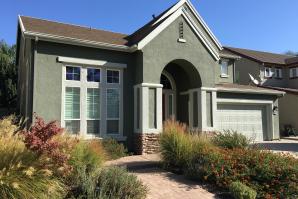Along a stretch of the Sacramento River sits a 20-ton art installation that seems to grow from nature, as if the earth sprouted a constellation of shimmering reflectors. Completed in November 2017, the sculpture plays with the eye’s perceptions, appearing to be an extension of the ground, trees and sky above. Light bounces from its metallic surface, challenging the brain to identify where nature ends and art begins. The piece, Subtile, is by Czech-Argentinian artist Federico Díaz, whose other installations are on display in Beijing, São Paulo and Buenos Aires, major world cities with dense urban cores.
While it’s a stunning sculpture, what may be most notable, perhaps, is its location — The Bridge District in suburban West Sacramento, located adjacent to Sacramento proper with a population of nearly 53,000 in 2016, according to the U.S. Census Bureau. West Sacramento’s investment is part of a growing trend among suburbs to urbanize their communities as high-density neighborhoods that provide the amenities and opportunities of city centers: Citrus Heights is infusing a residential community into its business district; Rancho Cordova is planning a mixed-use urban center with residential, employment and recreational opportunities; and Elk Grove is considering a multimodal transportation hub, the first in the Sacramento region.
Traditionally, suburban neighborhoods were bedroom communities that offered affordable housing, large lots and yards, and a quiet life away from the urban centers that served as hubs for employment, city services and recreation. But as suburbs grew in popularity, patterns of unsustainable sprawl, longer commutes, congested traffic, and a lack of diversity in housing options developed, creating a new host of challenges for metropolitan areas.
Related: Cyrus Abhar on Rancho Cordova’s rapid growth and development
Related: James Corless on transportation, housing and autonomous vehicles
As California struggles to meet rising housing demands and address the state’s policy to reduce greenhouse gas emissions — which will depend in part on alternative transportation methods — the Capital Region is positioned to look to the suburbs for answers.
MAPPING A NEW LAYOUT
Formerly an industrial zone, West Sacramento’s The Bridge District is now a thriving community that offers high-density affordable housing among retail and commercial development, with integrated recreation and plans for various transportation options to downtown Sacramento.
Its popularity makes it a model of urban planning the Sacramento Area Council of Governments envisioned when in 2004 it adopted the Sacramento Region Blueprint, a smart-growth vision for the metropolitan region, which includes Sacramento, Yolo, Sutter, Yuba, El Dorado and Placer counties.
“The blueprint is trying to look at what kind of growth is appropriate that is sustainable, that meets market demand and doesn’t force people to drive alone all the time and add to massive traffic congestion,” says James Corless, CEO of SACOG.
Younger generations, including those with children, want more urban amenities, like walkable communities, exciting social opportunities and restaurants no matter where they live, says Corless. That makes a project like Citrus Heights’ conversion of an old golf course into a 260-single family home community in its business district — walkable to dining, shopping and entertainment — an attractive option. With little land left to develop, the city must be strategic about how it diversifies infill projects. For example, it just signed a 15-year lease with Dignity Health Mercy San Juan, bringing medical care and high-paying jobs to its city center, explains Christopher Boyd, city manager of Citrus Heights.
Alternative housing options for those who can’t afford or don’t want a single-family home supports smart growth as well, by increasing density and affordability in existing communities. Roseville’s Sierra Vista housing development includes carriage units — detached garages that come with the option to build a housing unit above them.
Roseville homeowners can apply to add a tiny home to their property as a second housing unit, as long as it has a permanent foundation and hookups and meets the city’s setback requirements, building and safety codes, says Kevin Payne, development services director for the City of Roseville. The City is updating its second unit ordinance in response to new accessory dwelling unit provisions passed by the state, making it easier and cost-effective for homeowners to add a second housing unit on their property, considered by the state essential to address the housing crisis.
And suburbs like Rancho Cordova are well-positioned to embrace the region’s smart-growth plan. With land to develop and large growth potential with a 2:1 job to housing ratio, the City saw a need for an additional housing development, says Amanda Norton, economic development manager for the City of Rancho Cordova. Plans for Rio Del Oro, a 3,828-acre urbanized community — larger than Sacramento’s downtown and Midtown put together — are underway. The development will transform the suburb into an urban center along the Highway 50 corridor with diverse housing options, a strong business, retail and recreation component, and multiple modes of transportation.
“We believe there is a booming market and growing demand for apartments, even larger apartments, two to three bedrooms that are family oriented, but we have to get rid of state level red tape.”James Corless, CEO, Sacramento Area Council of Governments
While efforts move the region’s growth plan in the right direction, it’s still not enough. During the Great Recession, the Capital Region lost its construction industry, says Corless, leaving the remaining labor pool in high demand. That means higher building costs, which makes infill and attached housing projects too expensive to undertake, compounded by construction defect litigation, red tape and environmental rules that could be streamlined, he says.
“We believe there is a booming market and growing demand for apartments, even larger apartments, two to three bedrooms that are family oriented, but we have to get rid of state level red tape,” says Corless.
The Sacramento Region Blueprint calls for two-thirds of all housing projects in the Sacramento region to be on small lots, those less than 5,500 square feet. To date, the region only develops one-third of all new housing on small lots, with large lots — 5,500 square feet and above — consuming two-thirds of development, says Corless.
While the region needs to do a better job complying with lot sizes, no community or urban center, no matter how thoughtfully designed, is entirely self-sufficient. Local design must include regional accessibility and that means transportation modes that offer alternatives to people driving alone in their cars. And we’re beginning to see that.
In addition to Roseville’s internal bus system and shuttle that provides transportation to Sacramento daily, the City is working with Capitol Corridor, the train route between Auburn and San Jose, to increase the number of roundtrips made between Roseville and Sacramento from one per day to at least three in the next few years, and ultimately 10 per day, says Payne. That frequency will provide access to the buses, airports, shuttles, Bay Area Rapid Transit and ferries linked to several of the corridors’ 18 stations, designating the corridor as a viable primary mode of transportation for residents in and around the Roseville area.
The City of Rancho Cordova saw its proximity to the American River Parkway as an opportunity to incorporate bike trails throughout its planned Rio Del Oro urban center and newer neighborhoods. The plan is to link them to the Jedediah Smith Memorial Bicycle Trail along the American River Parkway — a heavily traveled stretch of 32 miles from Folsom’s Beals Point to Old Sacramento, with connecting bike trails to Davis and along the Sacramento River.
But how do you connect a metropolitan region that provides multiple modes of transportation for a growing population with significantly diverse needs? Elk Grove may have the answer. The city is evaluating a potential multimodal transportation hub — multiple transportation modes in one location for regional and statewide mobility. The hub could include a new Amtrak station for service between Sacramento and Bakersfield; light rail; bus rapid transit and regional buses; and could be accessible by foot, bike, transit or automobile.
The project aligns with the Sacramento Region Blueprint, which identified Elk Grove as a major job center in the region to help alleviate commutes and use our transportation network more efficiently, says Corless.
“If Elk Grove is going to lure jobs from Silicon Valley, out of state or grow existing companies, [it’s] got to have a transportation hub to be able to do that,” he says. “The multimodal transportation concept is exactly what you need to do in a lot of these suburban cities.”
THE WAY WE WORK
Suburbs are also looking at opportunities for residents to work where they live, and several are adopting the concept of coworking spaces — a shared workspace for entrepreneurs and business professionals from all industries. The concept alleviates congested commutes and the high cost of office space, provides access to a network of business professionals and skill development classes, and rents offices and conference rooms for meetings.
Related:Sierra College Welcomes Hacker Lab to Rocklin
Related: The Great Millennial Migration
InnoGrove, Elk Grove’s first coworking space, launched in fall 2015 and grew from monthly meetings among Elk Grove residents in tech, many of whom telecommuted or drove to Sacramento or the Bay Area. They met up at restaurants or coffee shops to discuss their work and the broader tech and innovation industry, but wanted a space to call their own.
But InnoGrove is different than its urban counterparts. While it offers programming typically found in other tech coworking spaces like mixers, hackathons and educational workshops, its suburban location caters to its strong demographic of families.
“We’re always adding tech and innovation workshops at InnoGrove for the kids,” says Steve Barnett, general manager at InnoGrove. It offers a customized solution for professionals with young children who can focus on their work, while their children learn valuable tech skills.
“There’s definitely a really big family vibe in [our location] in Rocklin, a different energy, a suburban feel.” Gina Lujan, CEO & co-funder, Hacker Lab
Hacker Lab CEO and co-founder Gina Lujan opened a second coworking space in Rocklin in 2016, after her first space proved successful in Midtown Sacramento. But she was skeptical a coworking space in Rocklin would work, given its smaller size and larger demographic of families vs. young professionals. To balance the risk, Lujan partnered with Sierra College, capitalizing on the institution’s engagement in maker-movement education and its inherent support of a makerspace open to its students and community.
Today, Lujan is glad she opened in Rocklin. “The space in Rocklin is thriving … It’s very family oriented. The one in Midtown mostly attracts millennials and young professionals. There’s definitely a really big family vibe in the one in Rocklin, a different energy, a suburban feel.”
Rancho Cordova resident and small-business owner Angela Lofton Moore, opened the first coworking space in Rancho Cordova, WorkFlow Lounge in October 2017. To date, the space has a vibrant community of over half of its 50 targeted members from a wide range of industries mostly within a 20-mile radius of Rancho Cordova.
Last year, the City of Rancho Cordova completed a feasibility study with Hacker Lab and sees the value of a second coworking space. More than 50,000 people work in Rancho Cordova, and 885 home-based businesses are licensed with the City.
“By providing our current residents other places to work or other styles of work that might inspire them, that’s important … People move here because they already see the entrepreneurial spirit is alive and well in Rancho Cordova. We really want to foster that and keep that growing,” Norton says.
OUT OF OFFICE
Beyond housing, employment and transportation, entertainment where people live is a critical component to successful communities. Elements of formal urban entertainment districts add the vibrancy of city centers that suburbs have traditionally lacked. Citrus Heights is bringing a 2,500-seat pop-up outdoor stadium to Sunrise Mall to host outdoor events and concert series. Rancho Cordova’s plan for Rio Del Oro integrates a strong recreation theme with 16.5 miles of bike trails, more than 500 acres of wetlands, 200 acres of parks and the largest community park in the Sacramento region. West Sacramento’s The Bridge District features a community vegetable garden and park; and The Barn, a stunning architectural feature that hosts popular entertainment events; farmers markets; and food trucks on the riverfront.
It’s about developing an engaging sense of community where people live. That’s what developer Allan Davis and his wife Nancy, who died in 2015, wanted for their community when they imagined the Milagro Centre in Carmichael. The center features seven uniquely different restaurants, with an eighth on the way, infused with establishments that began their roots in downtown Sacramento — Fish Face Poke Bar; Insight Coffee Roasters; River City Brewing Company; and new restaurant Mesa Mercado, by the owner of downtown Sacramento’s Tequila Museo Mayahuel. Patrons can enjoy an inviting common dining area with natural features, like a fountain and a fire pit, and a full-service event center.
Davis and his wife had the idea for the space more than 20 years ago after coming across a similar concept in Los Angeles. Longtime residents of Carmichael, the Davis’ essentially wanted to create the feel of downtown in their community. Events such as farmers markets, craft fairs, concerts and yoga are hosted in the center’s open space.
The restaurants at Milagro have largely been successful, but the communal spaces are still working to take hold. Sierra Beshears, Milagro’s event coordinator, says educating the community about the center’s opportunities has been a challenge. Curious passersby who see outdoor yoga hosted every Sunday have asked Beshears if the destination is a senior center. To be fair, Carmichael does have a sizable older demographic.
But events at Milagro are slowly becoming more popular, says Beshears. There aren’t other destinations in the community where people can walk around, enjoy a strong sense of community and a range of culinary options in one location like you can in a city center.
“We just loved Carmichael,” Davis says. “It’s where I’ve lived for 30 years, and we just wanted to bring something to Carmichael where people could gather and eat without having to drive to the other side of town.”
As the Capital Region grows, the manner in which our suburbs grow and adapt will have a significant bearing on its future vitality. “If we can position our suburbs and become a national leader in exciting, vibrant, compact suburban infill and revitalize our suburban corridors, we’re going to do great, and we’re going to be able to compete,” Corless says.
Zack Quaintance contributed to the writing and reporting of this article.
Recommended For You

Infographic: Placer County Keeps on Growing
Placer is no longer the small, rural county of old. It now boasts medium-sized cities, major employers and a population expected to grow at a faster rate than the rest of the region.

Elk Grove Ranked a Top Spot for Young Homebuyers
Young people are flocking to the Sacramento region’s suburban areas. A recent SmartAsset report — that defines millennial homebuyers as under age 35 — found that Elk Grove sits at the No. 2 spot in the U.S. for millennial home buying. In Elk Grove, “the homeownership rate for millennials was 60 percent in 2015,” according to the report.




Comments
What about the people who ALREADY live here? For instance, the handicapped and paraplegic community? How about we start helping them out with livable and affordable housing, instead of overpopulating our area more with Bay Area migrants and people who shouldn't have children because they can't afford them in the first place? California is severely behind the rest of the country in regard to public assistance and services for handicapped and paraplegic people.
Once again, Jennifer Berry has written a well-researched, beautifully written and articulate article. I always look forward to seeing her work in Comstock. This article has particular interest for me as I live in a small Bay Area city that insists on mixed-use buildings, to include housing as well as office and retail space. There are 3 of these going up in the downtown neighborhood in which we live and one huge project (built by Stanford ) soon to be started on the southern edge of the city. This provides hundreds of housing units as well as offices and retail. A public plaza is also included. There is also a move to examine one-person drives into the downtown and see how they can be eliminated. It's smart and it's necessary and I'm so happy to see the Bay Area take this on as well as Sacramento and the environs. Thanks for your article, Jennifer Berry!!!